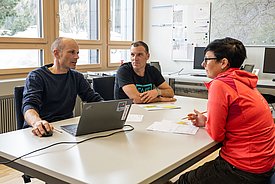30.04.2024 | Jochen Bettzieche | SLF News
Machine-trained algorithms assess the current avalanche situation in a similar way to humans - with different approaches, strengths and weaknesses.
This text has been translated automatically.
Forecast for Saturday, February 10, 2024, for southern Switzerland, issued by a forecast model developed with a lot of data and the machine learning (ML) method: Avalanche warning level 3 (significant) with a tendency towards 4 (large). After three years of testing, a model is sitting at the table for the first time this year when the employees of the avalanche warning service decide which danger level to assign to which region. The three-year lead time has already shown: The model's predictions are often good. "Sometimes they're clearly not, but even we're wrong sometimes," says avalanche warden Frank Techel. On February 10, the machine is pretty much of the same opinion as its three human colleagues (see picture).
The computer has learned to interpret the in-house physical model SNOWPACK for simulating the snowpack, some of which the avalanche warning service has been using for decades. In other words: what is new is not the use of algorithms in avalanche warning per se, what is new is that algorithms analyze and evaluate the results of other models such as the simulation of the snowpack and independently assess the situation.

The project was launched in 2019 and was initiated by SLF Director Jürg Schweizer. A team of SLF researchers and avalanche forecasters worked on it together with colleagues from the Swiss Data Science Center. For two years, physicist Cristina Pérez carried out experiments with different methods and data sets, processed data and ultimately trained the model. She drew on twenty years of weather data and snow cover simulations based on measurements from the Intercantonal Measurement and Information System IMIS. This approach is called machine learning. One of the challenges was to select the parameters in such a way that the algorithms became increasingly accurate. "On the other hand, it was difficult to achieve a good level of accuracy for avalanche warning level four, as this high warning level rarely occurred in the twenty years, so the database was quite small," says Pérez. The employees of the avalanche warning service call the platform on which they view the various ML models Palantir, after the seven crystal balls from J.R.R. Tolkien's fantasy world Arda with the most famous continent of Middle Earth, which show scenes far removed in space and time.
The human employees of the avalanche warning service use the same data and models for their work as the computer. But they also use information such as current observations in and feedback from the terrain. This data is not available to the computer. The algorithm relies exclusively on simulations of the snow cover as input. On the other hand, for reasons of time alone, humans select the data relevant to them from the mass of data, the machine does not. "Models allow a spatial and temporal resolution that we humans will never achieve," explains Techel. Humans and machines complement each other. The algorithms help to interpret basic data sets. Both sides also make mistakes. "The good thing is that the models make different mistakes to us," says Techel. The avalanche warning service thus receives a second, independent opinion and can reconsider its current result for the avalanche bulletin in the event of major discrepancies.
The team is currently developing the project further and wants to better combine human and machine forecasts in the future. "This also includes a more intuitive presentation of the results for the avalanche warning service," says Techel.
Contacts ¶
Links ¶
Copyright ¶
WSL and SLF provide image and sound material free of charge for use in the context of press contributions in connection with this media release. The transfer of this material to image, sound and/or video databases and the sale of the material by third parties are not permitted.
